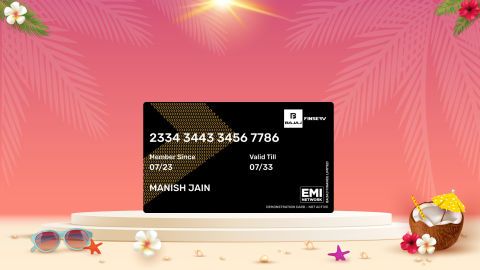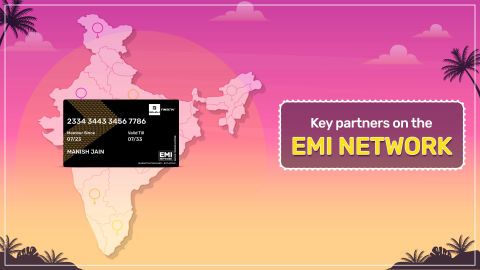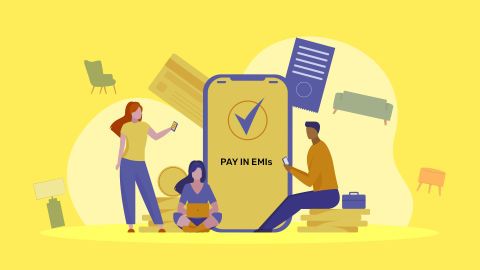Understanding the basics helps you make a smarter choice. OLED TVs use organic compounds that light up each pixel individually, allowing them to switch on and off independently. This results in true blacks, deep contrast, and ultra-slim designs.
QLED TVs, on the other hand, use quantum dots and LED backlighting. While they follow a different path, QLEDs produce bright images and vivid colours, making them great for well-lit rooms.
Why spend more when you can save more? Use the Maha Bachat savings calculator to combine dealer offers, brand offers, and Bajaj offers to bring down your purchase cost. Calculate your extra savings today!
A QLED TV is just an LCD TV with quantum dots
QLED TVs build on traditional LCD technology, with a twist—quantum dots. These tiny particles enhance colour brightness and accuracy when lit by a backlight. The result is vivid, punchy visuals that pop on the screen, especially in bright environments.
However, since QLED TVs still rely on backlighting, they cannot match the deep blacks or contrast levels of OLED. Yet, they offer impressive durability and are less prone to screen burn-in. If you prefer bright, colourful visuals in a sunlit room, QLED TVs are a strong contender.
An OLED TV is not an LCD TV at all
OLED TVs operate very differently from QLEDs. They use self-lighting organic pixels, which means each pixel produces its own light. This allows OLED TVs to completely turn off pixels for true blacks, infinite contrast, and outstanding uniformity.
Because OLED does not require a backlight, it enables ultra-thin displays and wide viewing angles without loss in image quality. Ideal for movie buffs and dark room viewing, OLED delivers cinematic brilliance. However, it may not be as bright as QLEDs, and prolonged display of static images can lead to burn-in in rare cases.
QLED vs OLED image quality
When comparing image quality, both technologies shine in different ways. OLED TVs deliver superior contrast, deeper blacks, and wide viewing angles, offering a more immersive viewing experience.
QLED TVs are incredibly bright, making them perfect for rooms with a lot of ambient light. They also perform well in terms of colour volume, and advanced models include local dimming for improved contrast.
Contrast and black levels
OLED TVs are unmatched in delivering true blacks and infinite contrast. Since each pixel can shut off completely, you get a picture with no light bleed.
QLED TVs, even with full-array local dimming, cannot turn off pixels individually. This can lead to slightly greyer blacks, although newer QLEDs still deliver impressive contrast for most settings.
Uniformity and viewing angles
OLED TVs maintain consistent colour and contrast from almost any angle, thanks to their self-illuminating pixels.
QLED TVs perform best when viewed directly from the front. At wider angles, colours and contrast may appear slightly washed out, although modern QLEDs have improved in this area.
Power consumption
OLED TVs are more power-efficient during darker scenes, as only the required pixels light up. However, they consume more power when displaying bright content.
QLED TVs have consistent power usage, as the backlight remains on regardless of content. If your screen time includes more bright scenes, QLED may prove more energy-efficient.
OLED TV sizes
OLED TVs are typically premium models and are available in various sizes such as 42-inch, 48-inch, 55-inch, 65-inch, 77-inch, 83-inch, 88-inch, and 97-inch.
QLED TV sizes
QLED TVs offer more affordability and come in a broader range of sizes: 32-inch to massive 110-inch variants. You can find an ideal fit whether you need a compact bedroom TV or a living room showstopper.
Before you decide, explore the latest offers. You may find a great deal on a model that matches your needs.
Get electronics and appliances on Easy EMIs with Bajaj Finserv
Upgrading your home with the latest electronics and appliances is now easier and more affordable with Bajaj Finserv’s flexible financing options. You can also maximise your savings by using the Maha Bachat Savings Calculator—a smart tool that combines brand offers, dealer offers, and EMI offers, all in one place, helping you lower the overall cost while still paying in small, bite-sized instalments. Follow these steps to get started:
Explore products on Bajaj Mall: Browse a wide range of electronics and appliances from trusted brands. Compare features like energy ratings, storage capacity, performance settings, and design to choose the right product for your home.
Visit a partner store: Once you shortlist a model, step into any of Bajaj Finserv’s 1.5 lakh partner stores across 4,000 cities in India. See the product in person, talk to experts, and make a confident decision.
Choose the Easy EMI Loan option: At checkout, select the Bajaj Finserv Easy EMI Loan. Avail financing of up to Rs. 5 lakh and split the cost into convenient monthly instalments. Some products also come with a zero down payment option.
Check your loan eligibility online: Plan better by checking your loan eligibility in minutes. Simply enter your mobile number and OTP to know your pre-approved limit.
Use the EMI Network Card for purchases up to Rs. 3 lakh: Already own the Bajaj Finserv EMI Network Card? Use it for instant, paperless checkout and convert your purchases of up to Rs. 3 lakh into Easy EMIs.
TV by brand
TV by features
TV by size
TVs by brands
TVs by budget













